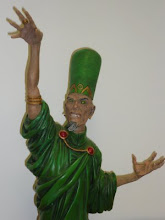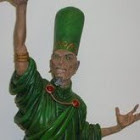A very enjoyable and engaging collection of influential ghost stories. For each story T.W. Burgess provides information showing the famous descendants of the story and its elements.
The Greek Myth-The House in Athens. Pliny the Younger (Writer) Mike O’Brien (Art). A house in Athens was haunted by a ghost who rattled chains. No one would love there until a philosopher heard the story and chose to investigate. T.W. Burgess traces the ghost of Jacob Marley from a Christmas Carol shaking his chains at Scrooge back to classical Greece and a haunted house in Athens in a story told by a Roman senator. Mike O’Brien’s art catches the time and mood without being stiff or archaic. It is expressive and gives the story the right pace to be both ancient and fresh. The muted colouring gives the story the atsmohere is deserves and brings out the details of the art.
The German Legend- The Death Bride. Friedrich August Schulze (Writer) David Romero (Art). A dreadful promise of revenge made by a deserted lover to be at the wedding of the man who broke her heart. T.W. Burgess connects the story to one of the most important horror stories ever written, Frankenstein. The creature makes a fatal promise to his creator that he keeps. The structure of the story is a Gothic classic of a story within a story that has a framing device of an Italian Marquis telling the story of The Death Bride. The Marquis was staying with a family, one of whose daughters had died. The Duke of Marino arrived and soon was planning on marrying the second daughter, the twin of the deceased. The Marquis was not happy with this as he had some knowledge about the Duke, and he told the story of the Death Bride which seemed very disturbing to the Duke. There is a wedding and there is trouble. It is a great story, beautifully told and constructed, down to the surprise at the conclusion. David Romero’s art is a perfect match to the story, it allows the layers to be seen they unfold and gives the expressive cast the chance to draw in the reader and to enjoy the lovely mix of the romantic and the gothic. The colouring gives the shadows and candlelight the place they deserve.
The Italian Fable- The Wild Huntsman. Gottfried August Burger (Writer). Brian Coldrick (Art). A Count loves to hunt and pursuing a white stag ignores al the advice to stop until he finds that his hunting has led him much further astray than he could have imagined. T.W. Burgess links the wild hunt to the Headless Horseman of Sleep Hollow. Brian Coldrick’s art delivers the story with energy and force, the cast are given a slightly fairy tale look as they chase their way to doom, the Count constantly spurning the advice to take care as he gets lost in the desire of the hunt. The colours are a careful arrangement of shades which bring out the autumnal setting and the steadily darker tone of the story. The cast are boldly drawn and subtly expressive.
The Japanese Folk Tale – The Tale of Dish Mansion. Baba Bunko (Writer), Bri Neumann (Art), Bryan Valenza (Colours). A maid in the house a police official as an accident. The police official is furious and punishes the maid very savagely. The main commits suicide and returns to haunt the house. T. W. Burgess links the story to the Japanese horror classic, The Ring, for myself I saw a connection to one of Arthur Conan Doyle’s best ghost stories, The Brown Hand. Bri Neumann’s art is lovely, a stylish take on Japanese forms that is never a copy. It moves and breathes with confidence and captures the tones and styles of the story. Bryan Valenza’s colours complement the art perfectly, they are clearly intended to invoke Japanese colouring without ever trying to simply copy it.
Early Haunts is a treat for any fan of ghost stories or comics, T.W. Burgess has chosen the stories with great care, writes about them with interesting and persuasive detail and had delivered a warmly enjoyable book.



No comments:
Post a Comment